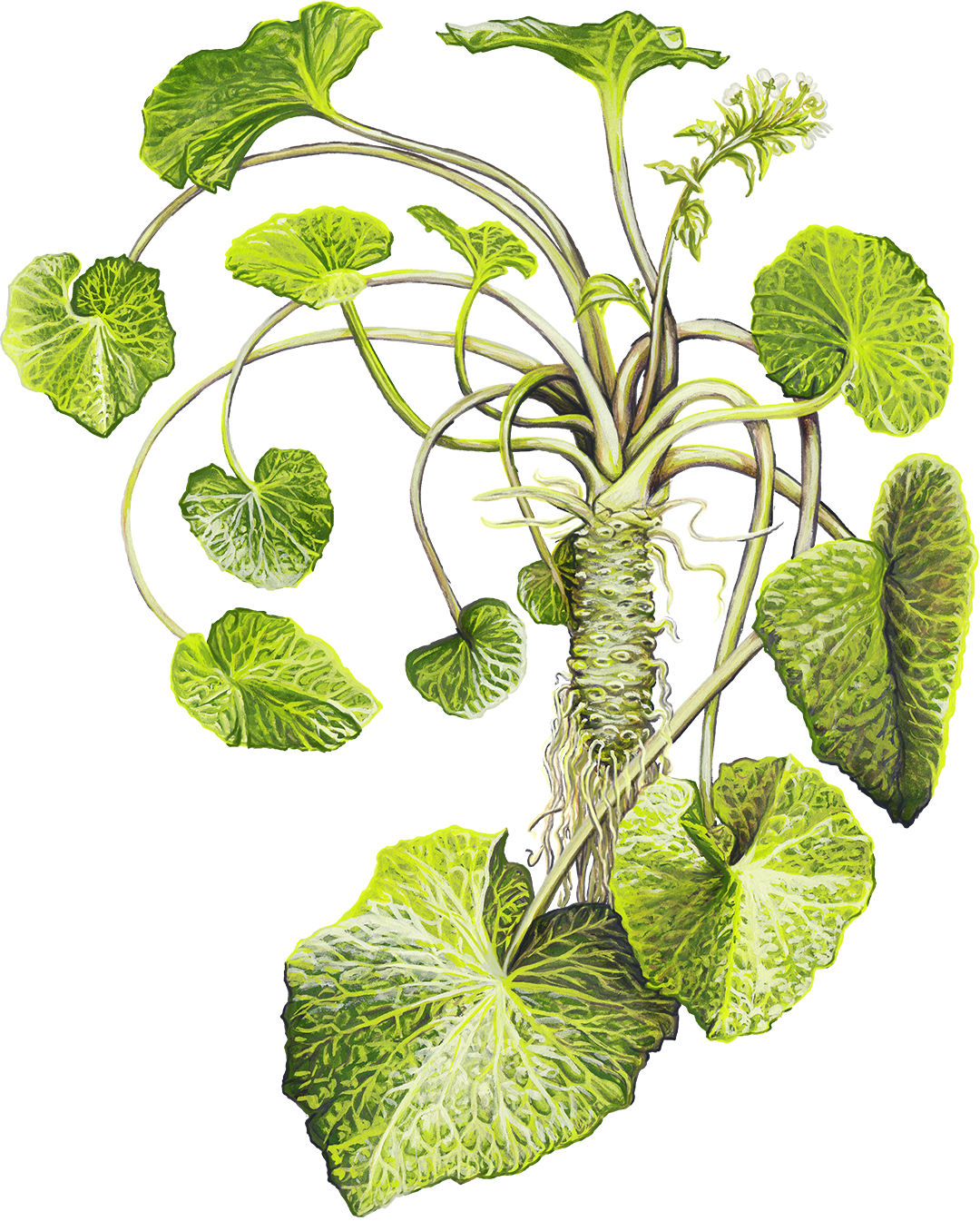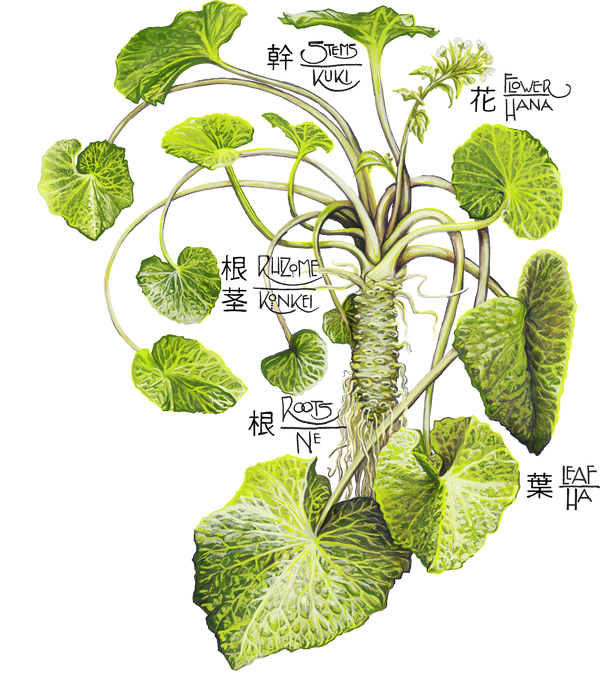
What is Wasabi?
Share
Wasabi is a glorious plant with medicinal, cosmetic and culinary capacities that has been used for thousands of years. It is a semi-aquatic, evergreen herbaceous perennial that belongs to the brassicaceae family and grows wild in the shaded canyons and steep ravines of coastal and mountainous areas of Japan. Wild wasabi ranges in growth from China, Taiwan, Korea and Japan.
Wasabi can be cultivated many ways, but only 'Sawa', or spring water grown wasabi is used by elite chefs in Japan. This is due to flavor. If wasabi is grown in soil, the meristem often does not have good texture when grated, and the flavor is off. There can be no sweetness. The pungency can vary wildly, and the wasabi umami earthiness is often non-existent. This is not all the time. There are methods using fertilizers and chemicals that can produce quality flavors, but nothing compares to sawa grown wasabi. Soil grown wasabi, or hatake wasabi, is cultivated mostly for the leaves and leaf stems, and is more common in Taiwan, China and South Korea.
Freezing cold spring water and the quality of this water is critical in achieving the highest potentials in the plant. Flowing water stimulates the root systems, which accumulate isothiocyanate and glucosinolate compounds, especially to the meristem, over wasabi's 2-3 year growth cycle. The quality of the water dictates the health and flavor of the plant and wasabi is a reflection of the water over time. The better the water, the better the plant.
Real wasabi has a completely different flavor than the frankenstein stuff out there. It's much less pungent. More sweet. With a delicious earthy umami characteristic to wasabi. It cannot be bottled because the chemical reaction cannot be stabilized. It's like a magic trick. After grating, the flavors of wasabi increase in the first 2-4 minutes, then stabilize for 7-10 minutes. After about 15 minutes, it's all gone. These compounds act as a natural defense mechanism. If a deer or predator macerates wasabi in the forest, a chemical chain reaction begins, intensifying the pungency with each chew. This deters predators from eating it. These pungent defensive compounds are known as isothiocyanates.
Sawa wasabi when grated with a proper oroshiki should have a creamy and vibrant texture. If the plant is grown too fast or with chemicals, the grind texture will be watery, and the characteristic wasabi earthiness flavor dulled. If the plant is grown too slow, or with alternative methods, the grind will be a bit thick and sticky and often times the taste is bitter. This is a sign of a plant that is not healthy. I have this with my wasabi that struggle to grow, or do not get enough water.
Different strains of wasabi will also produce different colored cream and varying flavors. And there are 100's of strains. Many of these strains have been developed over many generations by regional farmers and have adapted to their ecological proximity. More recently, collaborations with the JA (Japan Agricultural governing body) and university research departments have created strains that grow bigger, are more resilient, but retain wasabi's characteristic flavor notes.
Mazuma is considered the king of kings and one of the original strains of wasabi. It has purple leaf stems that emerge from the crown, and when you cut the meristem (root), you'll find a small purple ring just inside the bark. When grated, mazuma has a darker, almost lavender tint which lends the strain it's famous pungency. Misho on the other hand produces a vibrant green cream, almost neon. Chefs love misho also because it has a nice sweetness with beautiful color, and medium to mild pungency. This is the strain we grow at Shasta Wasabi. Mazuma and Misho are also the two primary varietals sold in Ota vegetable market in Tokyo, with mazuma costing considerably more (longer grow time).
Varying strains of wasabi can be more pungent, or sweeter. The slower growing strains such as Mazuma, Iraka, Shogun, etc. tend to have a much higher isothiocyanate content. These are the pungency compounds. Faster growing strains tend to be a bit more watery with less pungency, but some can be much higher in glucosinolates, or sweeter. Misho fits this description.
There are many classifications and terms for wasabi.
TERMINOLOGY:
Hon wasabi - Refers to the species or genus of wasabi from Japan known as Wasabia Japonica or Eutrema Japonicum. This is the botanical plant that is famous as an accompaniment with sushi, soba, etc.
Seiyo Wasabi - Western wasabi, or horseradish. Although both wasabi and horseradish are in the brassica family, they are completely different plants. Horseradish originates from Eastern Europe and is grown in the ground.
Sawa Wasabi - Also known as Mizu Wasabi, spring-water wasabi grows in cold, clear waters that flow through the valleys and gorges of deep mountain areas of Japan and is cultivated in places with similar conditions. The optimal locations for cultivation are abundant with spring-water that maintains a temperature of ≤16°C in the summer and ≥10°C in the winter, surrounded by deciduous woodland, shaded by tree cover in the summer, yet still able to receive the warm rays of sunlight that pass through the gaps between the trees. The Izu district in Shizuoka Prefecture has the optimal conditions for sawa-wasabi cultivation.
Hatake Wasabi - Hatake wasabi, or hata translates to "field" and is grown in soil. Primarily cultivated for the purpose of harvesting leaves using forced cultivation (greenhouses). This method is popular in Shizuoka, Nagano, Shimane, and Yamaguchi Prefectures, as well as in Tokyo. Hatake methods are also being used overseas in countries such as Taiwan, Indonesia, Canada, Australia, and the United States. The majority of hatake wasabi is used for processed products such as wasabi-zuke (pickled wasabi) and wasabi paste.
Alternative Wasabi - An expansion on Hatake, this term refers to any wasabi grown using hydroponic, aquaponic, aeroponic, sprinklers, or any synthetic method of growth not spring-water or soil based.
HISTORY:
The first mentions of wasabi in Japanese text were found on wooden strips used for medicinal purposes in the remains of Enchi (garden pond) in Nara Prefecture during the Asuka period (538-710ad). This indicates the possibility that wasabi was grown as a medicinal plant. In the Heian period (794ad) the word "wasabi" can be found in "Honzo Wamyo," Japan's oldest encyclopedia of medicinal plants.
Culinarily, wasabi cultivation began in the early Edo period (1603-1868). Upon being presented with wasabi, Tokugawa Ieyasu—said to have been a gourmet who lived a comparatively long life—fell in love with the ingredient. Furthermore, the wasabi leaf resembles the hollyhock leaf that was used as the Tokugawa family crest. Tokugawa treasured the plant, keeping it exclusively inside his private territory and forbidding consumption of the plant by the public. During the Keicho era (1596–1615), Utogi farmer Mochizuki Rokuroemon is said to be the first commercial farmer in the history of wasabi cultivation.
Wasabi is first thought to have begun being used in the modern way during the Bunka/Bunsei era of the late Edo period (1804–1830). The concept of hand-formed sushi with wasabi resulted in a sushi boom throughout Edo, which then spread to the common people. During this period, there were no refrigerators or refrigerated facilities. It is thought that Edo sushi chefs started using wasabi regularly because it reduced strong fishy smells, stopped bacterial growth, and prevented food poisoning.
Refrigeration and distribution technologies had not yet developed during the early Taisho period (1912-1926), but wasabi purveyors took a hint from tea processors and began drying and powdering wasabi—this was the birth of powdered wasabi. Afterwards, powdered wasabi made from horseradish was developed. In 1971, this mixture was developed into "wasabi" paste in small packets, and finally in 1973, turned into the wasabi we commonly see in everyday use today.
FUTURE:
The future of wasabi is complex. There are many variables working against the future of sawa wasabi grown in Japan. Farmers are aging, and wasabi is a laborious plant to farm and takes a physical toll. Younger generations are opting for urban life and easier work. Climate effects cultivation on a variety of levels. Typhoons can wash out an entire wasabida in one storm. Rising temperatures stress the plant, forcing farmers to move operations to higher elevations. Droughts disturb the delicate balance of rainfall needed to replenish low altitude mountain aquifers. The challenges are many. And they are getting bigger.
On the brightside, demand for wasabi is greatly increasing, especially outside of Japan, and some farmers are looking into exporting more product. There has also been an increase in wasabi farms being built outside of Japan. The price for wasabi has created a frenzy of different experiments, both large and small. Some are successful, some are not. What I can say is there is no wasabi that I've tasted that compares with sawa grown wasabi. There's a difference. And it can be substantial.
